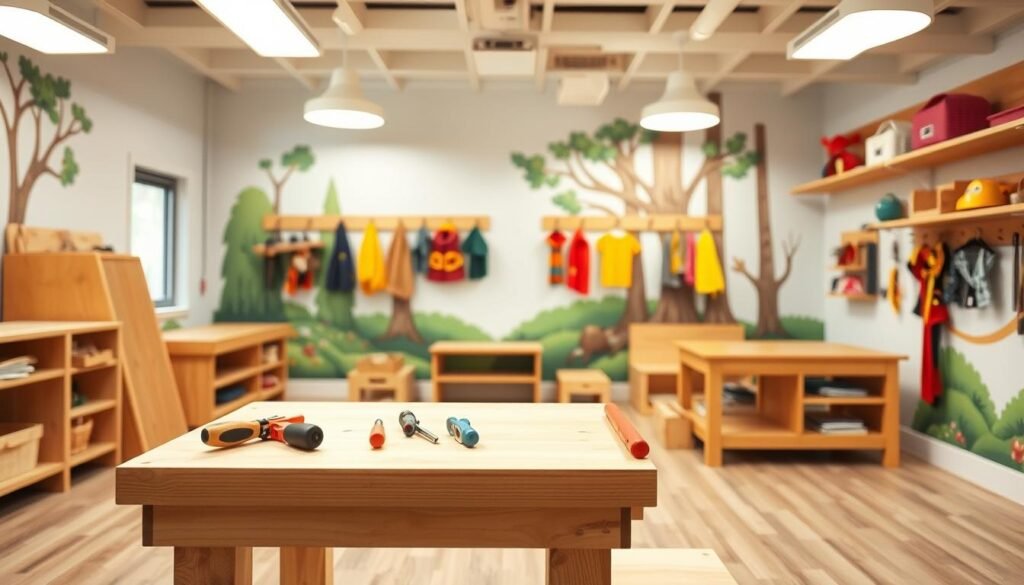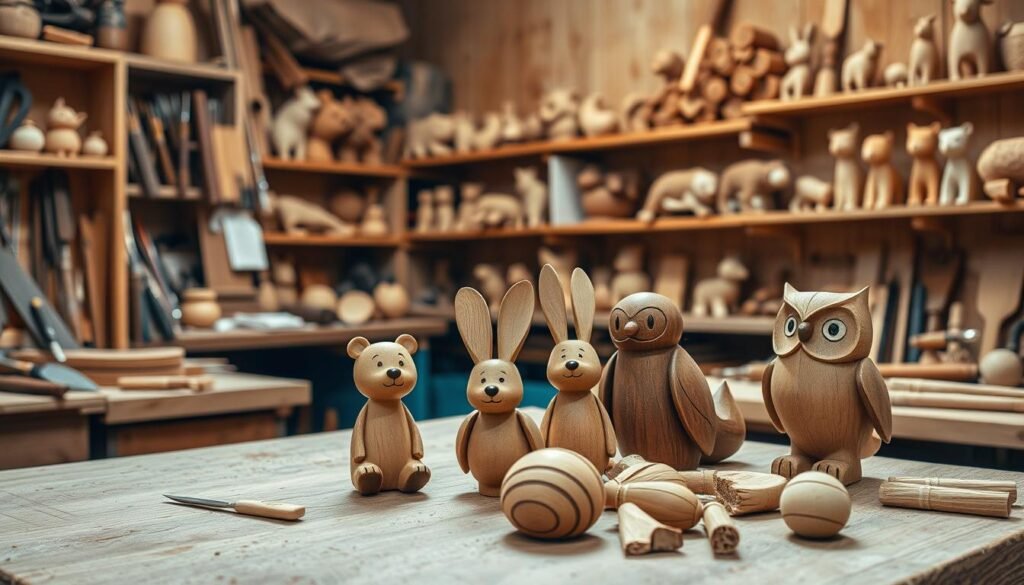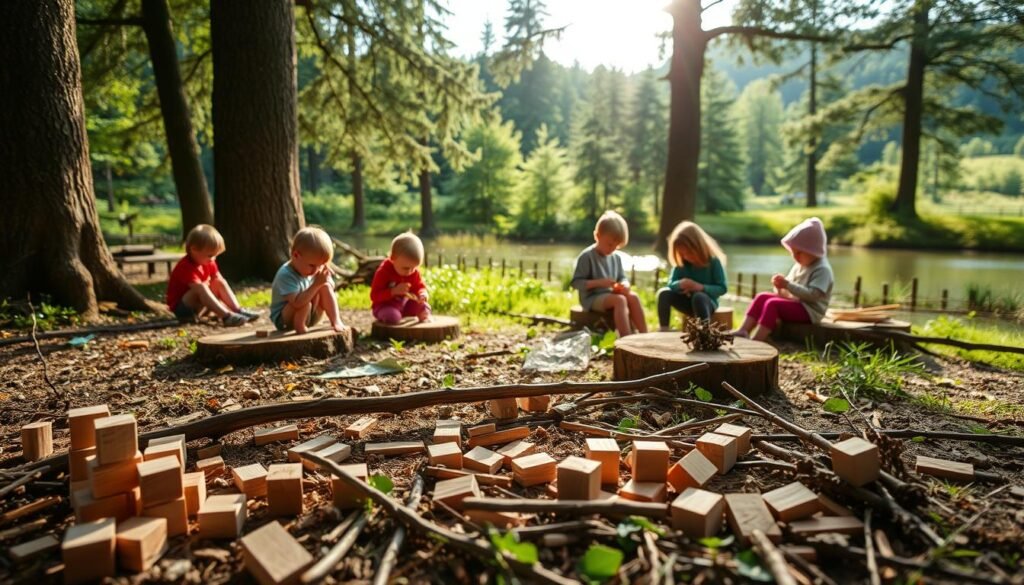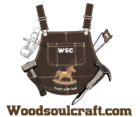Introducing your little ones to DIY activities can be very rewarding. Engaging in easy woodworking projects boosts their creativity and helps with fine motor skills. As a parent or caregiver, you’re key to making it fun and educational.
Starting something new can seem scary, but we’re here to help. With our guide, you’ll learn to make woodworking a delightful adventure for your preschoolers. We want DIY to be fun and easy for young children.
Key Takeaways
- Discover simple and fun woodworking activities for preschoolers.
- Learn how to create a safe and engaging environment for DIY exploration.
- Understand the benefits of introducing woodworking to young children.
- Find out how to choose the right tools and materials for your little ones.
- Get tips on how to make woodworking a fun, educational experience.
Why Introduce Woodworking to Preschoolers
Woodworking activities can greatly benefit preschoolers. It helps improve their thinking and motor skills. By starting early, we teach them more than just woodwork. We help them develop important life skills.
Developmental Benefits for Young Children
Woodworking projects for kids have many developmental benefits. They improve problem-solving, hand-eye coordination, and creativity. Kids learn to think critically and make choices about their projects.
This hands-on learning is key for young children. It prepares them for future success in school and life.
Building Confidence Through Hands-On Learning
Woodworking is great for building confidence in preschoolers. As they finish projects, they feel proud and accomplished. This confidence helps them face new challenges and explore their creativity.
By supporting kids in woodworking, we help them grow. We give them a strong base for learning and personal growth throughout their lives.
Safety First: Creating a Child-Friendly Woodworking Environment
To make woodworking fun and safe for preschoolers, we need to follow some rules. Woodworking with kids requires careful safety steps. We must balance their creative needs with the risk of getting hurt.
Age-Appropriate Safety Rules and Guidelines
It’s key to have clear safety rules for kids. For preschoolers, this means not touching tools without asking and keeping long hair back. We should explain these rules in simple terms. Here are some important guidelines:
- Always wear safety goggles.
- Keep loose clothing tied back.
- No running or horseplay in the workspace.
Setting Up a Safe Workspace for Little Hands
Creating a safe workspace is more than just rules. It’s about making a place where kids can explore safely. This means securing the workspace to avoid accidents. Tools should be out of reach, and the area should be free of clutter. We should also think about how to make it easy for adults to watch over them.

Adult Supervision Requirements
Adult supervision is very important when kids are woodworking. An adult should always be there to help, guide, and enforce safety rules. This helps prevent accidents and teaches kids how to use tools safely.
By following these steps, we can make woodworking safe and fun for preschoolers. It helps them grow creatively and develop skills in a safe place.
Essential Tools and Materials for Woodworking Projects for Preschoolers
Woodworking with preschoolers needs careful tool and material selection. This ensures a safe and fun experience. You’ll learn about the key tools and materials for a great woodworking space for your child.
Child-Safe Woodworking Tools
Safety is key in woodworking with preschoolers. Choose tools that are safe and effective for little hands. Some good options include:
- Soft-grip hammers or mallets
- Plastic or wooden sanding blocks
- Pre-cut wood pieces to minimize sharp tools
These tools are child-safe and let your preschooler enjoy woodworking. Always supervise them.

Best Types of Wood for Preschool Projects
Choosing the right wood is important for preschool projects. Look for wood that’s soft, easy to work with, and safe. Some good choices are:
| Wood Type | Characteristics |
|---|---|
| Pine | Soft, lightweight, and easy to cut |
| Balsa | Very soft, ideal for small projects |
| Poplar | Soft, less expensive, and versatile |
These woods are great for DIY woodworking projects with preschoolers. They offer a good mix of durability and ease of use.
Additional Supplies You’ll Need
There are more supplies needed to start. These include:
- Safety goggles
- Dust masks (for adults)
- Workbench or table
- Clamps
- Paint and non-toxic finishes
Having these additional supplies ready makes woodworking fun and safe for your preschooler.
Simple Wooden Block Projects
Introducing preschoolers to woodworking can be a delightful experience with simple wooden block projects. These projects not only foster creativity but also help develop fine motor skills and hand-eye coordination. We will guide you through creating engaging and educational wooden block projects that your children will love.

Step-by-Step: Painted Building Blocks
Creating painted building blocks is a fun and easy project that can be customized to your child’s favorite colors. Start by cutting wooden blocks to the desired size. Sand them to ensure they are smooth and safe for your child to handle. Then, let your child’s creativity shine by painting the blocks with bright, non-toxic paints. Once dry, these blocks can be used for building and stacking, which enhances your child’s motor skills and creativity.
Creating Simple Shape Sorting Toys
Shape sorting toys are excellent for cognitive development. To create one, cut various shapes out of wooden blocks, such as squares, circles, and triangles. Create a corresponding base with cutouts for each shape. Your child can then learn to sort the shapes by fitting them into the correct slots. This activity not only teaches shapes and colors but also improves problem-solving skills.
Both of these simple wooden block projects are perfect for introducing your preschooler to the world of woodworking. They are safe, educational, and most importantly, fun!
Easy Wooden Animal Crafts
Easy wooden animal crafts are great for kids to learn woodworking basics. They boost creativity and help improve fine motor skills. Let’s look at two fun projects: making wooden stick animals and a simple bird feeder.
How to Make Wooden Stick Animals
Wooden stick animals spark imagination and creativity in kids. You’ll need wooden sticks, glue, scissors, and paint or markers. Cut the sticks into different lengths for animal parts like the body and legs.
Help your child glue these parts together. Then, let them decorate their animal with paint or markers.

Building a Simple Wooden Bird Feeder
Building a bird feeder is a fun project that teaches kids about woodworking and wildlife care. You’ll need a wooden block, peanut butter, birdseed, and string. Spread peanut butter on the block, then roll it in birdseed.
Attach a string to hang the feeder. This project teaches kids about caring for birds and wildlife.
| Project | Materials Needed | Skills Developed |
|---|---|---|
| Wooden Stick Animals | Wooden sticks, glue, scissors, paint/markers | Creativity, fine motor skills |
| Wooden Bird Feeder | Wooden block, peanut butter, birdseed, string | Understanding of wildlife care, hand-eye coordination |
Fun Woodworking Projects That Develop Fine Motor Skills
Woodworking activities can greatly improve a child’s fine motor skills and hand-eye coordination. At a young age, kids start learning to handle objects. Woodworking lets them practice these skills in a fun, creative way.

Wooden Bead Threading Activities
Wooden bead threading is a simple yet effective way to improve fine motor skills. Kids thread wooden beads onto a string or cord. This helps them practice their pincer grasp and hand-eye coordination.
To make it more fun, you can create wooden beads in various shapes and sizes. This lets your child sort and thread them in different ways. Craft experts say,
“Threading beads is an excellent way to enhance fine motor skills in young children, as it requires precision and coordination.”
This activity boosts dexterity and problem-solving skills. Kids learn to arrange the beads in different ways.
Beginner Hammering Projects
Beginner hammering projects are also great for developing fine motor skills. Kids use a small hammer and soft wood to practice hammering. They learn to control the force and direction of their swings.
Making a wooden picture frame or a small birdhouse is a good way to start. A woodworking expert recommends using soft woods like pine or cedar. They are easy to hammer and less likely to split, making them perfect for beginners.
Nature-Inspired Woodworking Activities
Exploring the outdoors with our little ones can turn into a woodworking workshop. It fosters creativity and curiosity. Nature-inspired woodworking activities help preschoolers appreciate the environment and develop their crafting skills.
Collecting and Crafting with Sticks and Twigs
Collecting sticks and twigs is a fun outdoor activity. It leads to a creative woodworking project. These natural materials can be used to make:
- Picture frames
- Simple sculptures
- Decorative mobiles
These activities boost creativity and teach children the value of natural materials.

Creating Leaf Print Wooden Coasters
Creating leaf print wooden coasters is another engaging project. It involves:
- Collecting leaves of various shapes and sizes
- Arranging them on wooden coaster blanks
- Using paint or ink to create leaf prints
This activity teaches children about different leaf types. It also shows them how to create art from natural elements.
By adding nature to our woodworking projects, we give preschoolers a unique learning experience. It combines creativity, environmental awareness, and hands-on skills.
Seasonal Woodworking Projects for Preschoolers
As the seasons change, so do the fun woodworking projects for preschoolers. These projects boost creativity and help kids understand the world. We’ll look at how to make woodworking projects for each season, using holidays and outdoor fun.
Holiday Ornaments and Decorations
Woodworking with preschoolers is fun, like making holiday decorations. For Christmas, cut out shapes from soft wood and let kids paint them. This activity improves their fine motor skills and creativity. For Halloween, make wooden bats or ghosts to hang in windows. Using bright colors and fun designs makes these projects more engaging.

Outdoor Projects for Each Season
Outdoor woodworking projects connect kids with nature. In spring, make wooden plant markers or birdhouses. Summer is great for wooden garden benches or bird feeders. These projects teach kids about nature and the changing seasons. Autumn is for wooden leaf rubbings or a leaf wreath. Winter is for wooden snowflakes or a simple sled.
Adapting woodworking projects to the seasons keeps crafting fun and fresh all year. It’s a great way to mix fun with learning and growth.
Adapting Woodworking Projects for Different Ages
Woodworking with preschoolers needs projects that fit their age and skill. This keeps them interested and challenged, but safe for their age.
Projects for 3-Year-Olds
Three-year-olds do well with simple tasks like wooden block stacking or hammering soft wood. These activities improve their fine motor skills and hand-eye coordination. We use soft woods and blunt tools for safety.

Projects for 4-Year-Olds
Four-year-olds can handle more, like assembling simple wooden puzzles or creating wooden shapes. These projects boost their problem-solving and creativity. Safety and supervision are key.
Projects for 5-Year-Olds
Five-year-olds can do more complex tasks, like building simple birdhouses or crafting wooden animals. These projects sharpen their fine motor skills and introduce woodworking basics. Teaching tool use and safety is important.
| Age | Project Examples | Skills Developed |
|---|---|---|
| 3 | Block stacking, hammering soft wood | Fine motor skills, hand-eye coordination |
| 4 | Simple wooden puzzles, creating wooden shapes | Problem-solving, creativity |
| 5 | Building simple birdhouses, crafting wooden animals | Fine motor skills, basic woodworking techniques |
Adjusting woodworking projects for different ages makes it safe and fun. It also builds a love for making things. By matching projects to the child’s age, we help them grow creatively and skillfully.
Conclusion: Nurturing Young Woodworkers
Introducing woodworking to preschoolers is rewarding for both kids and parents. It helps young ones develop important skills and builds their confidence. It also sparks a lifelong love for making things.
We’ve looked at woodworking projects perfect for preschoolers, from simple blocks to nature-themed activities. These projects improve fine motor skills and hand-eye coordination. They also boost creativity and self-expression. Keep making projects fun and suitable for your child’s age and skill level.
This way, you’ll help your child gain valuable skills that last a lifetime. Explore more woodworking projects for preschoolers. Watch your child’s confidence and creativity grow. With patience and the right projects, you’ll raise young woodworkers who will keep creating and innovating.
🛠️ Want the Look Without the Sawdust? Here’s Your Shortcut
There’s something rewarding about building a wooden piece with your own hands—but let’s face it, not everyone has the time, tools, or space for a full DIY project.
💡 That’s why I recommend Ted’s Woodworking Plans – a massive library of 16,000+ step-by-step plans for every kind of woodworking project you can imagine. From pet houses to holiday gifts, you’ll get:
✨ Easy-to-follow blueprints
🧰 Complete material & cut lists
🪚 Projects for all skill levels
👉👉 Start your woodworking journey with Ted’s 16,000 plans »
🛒 Prefer to Buy Instead of Build?
No problem! If you love the look of handcrafted wood but would rather skip the tools, we’ve got you covered.
🌿 👉 Browse top-rated wooden toy and get inspired on Amazon »
📘FAQ
What are some easy woodworking projects for preschoolers?
What safety precautions should I take when doing woodworking with preschoolers?
What type of wood is best for preschool woodworking projects?
Can I do woodworking projects with my 3-year-old child?
How can I adapt woodworking projects for different ages?
What are some fun woodworking activities for preschoolers that develop fine motor skills?
Can I do woodworking projects with my child if I have no experience?
What are some seasonal woodworking projects I can do with my preschooler?
Are there any kid-friendly woodworking tools available?
Affiliate Disclosure
Some of the links in this article are affiliate links. If you click through and make a purchase, I may earn a small commission — at no additional cost to you.
This helps support my work so I can continue creating helpful woodworking tutorials and product reviews.I only recommend products and services that I have thoroughly researched and believe could provide real value to my readers.
Thank you for your support!

